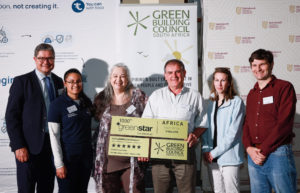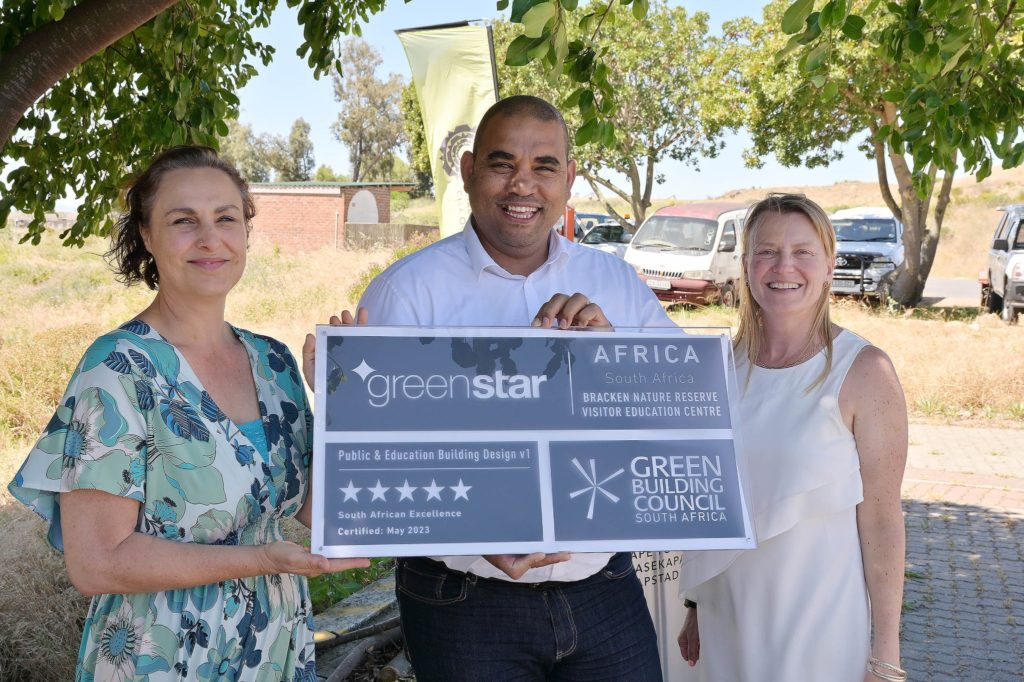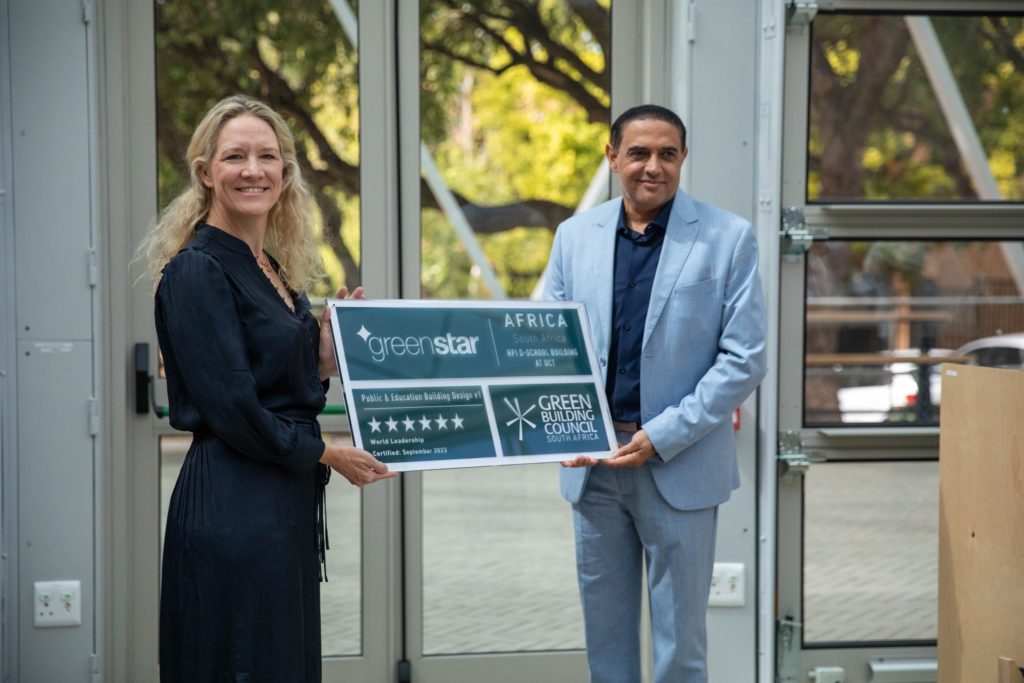


In an insightful podcast hosted by Rainmaker Marketing, Our Western Cape General Manager Natalie engaged in a compelling conversation with Georgina Smit, the Head of Technical and Executive Director at The Green Building Council South Africa (GBCSA). With a formidable background in sustainable consulting and a significant role in developing the Silo Precinct at the V&A Waterfront, Smit’s insights into green building practices are invaluable. The podcast covered a broad spectrum of topics, including the GBCSA’s mission, the importance of certification, milestones in green building, and the future trajectory of sustainable practices in the built environment.
The GBCSA stands as a beacon for sustainability in the built environment across South Africa. Through its collaborative efforts with a diverse membership community, the organisation aims to ensure that commercial, residential, and public sectors embrace environmentally sustainable practices in design, construction, and operation. Smit described her comprehensive role, which spans overseeing certification processes, developing training programs, and leading research initiatives. These efforts are designed to arm decision-makers and professionals in the built environment with the necessary tools to achieve resilience against climate change.
Certification is more than a badge; it’s the proof to a building’s genuine green credentials. Smit passionately articulated the value of certification in guiding the property sector and validating claims of sustainability, thereby preventing greenwashing. She elaborated on the variety of certifications tailored to different types of buildings and their life cycle stages, including the renowned Greenstar and Edge certifications. These frameworks are vital for stakeholders to ensure their projects not only claim but truly embody green principles.

The 1000th certification went to the remarkable Visual Arts Building at Stellenbosch University. This achievement has been 15 years in the making, showcasing the growing demand for sustainable and resilient green buildings in South Africa’s built environment sector. (Oct 2023)
2023 marked a historic moment for the GBCSA and the broader green building movement in South Africa, achieving the 1000th certification. This milestone reflects the collective efforts and progress within the sector, showcasing a significant shift towards sustainable building practices. However, Smit emphasised the ongoing journey ahead, indicating the need for continuous improvement and adoption of green practices.

GBCSA, the City of Cape Town, and the Bracken Nature Reserve Visitor Education Centre project team recently celebrated their 5-Star Green Star Public and Education Building Design v1 certification with a special plaque handover at the reserve. (Nov 2023)
The Green Star rating system is pivotal in evaluating a building’s sustainability performance. Smit discussed the various levels, from 4-star, indicating industry best practice and 5-star which is South African excellence to 6-star, which signifies world leadership in green building. The increase in buildings achieving higher ratings is a positive sign, demonstrating a commitment to exceptional and innovative sustainable design and practices. However, she noted that only a small percentage (5%) of the portfolio currently achieves these standards, highlighting the room for growth and advancement.

Edge certification focuses on significant improvements in energy, water, and embodied carbon savings. Smit shared exciting developments in the residential sector, where several projects achieved preliminary Edge status in 2023. This is particularly impactful as the residential sector accounts for a substantial portion (40%) of energy consumption in South Africa. She underscored the tangible benefits for homeowners, including utility savings and improved living conditions through strategic architectural design, which can lead to cost reductions and a positive environmental impact.
A prevalent misconception is the presumed high cost of adopting green building practices. Smit addressed this by referencing research that provides a clearer picture of the actual costs. Initially, green buildings were thought to be significantly more expensive, but recent studies show that the premium has decreased from 5% to an average of 3.5%. When examining the more cost-effective end of the spectrum, we observe green buildings achieving certification with a premium of less than half a percent. This highlights the feasibility of sustainable construction practices at minimal additional cost, showcasing the efficiency and affordability of green building initiatives.
This reduction highlights the industry’s maturation and the availability of cost-effective solutions for sustainable building. Smit encouraged stakeholders to challenge the notion that green building is prohibitively expensive and to consider the long-term benefits.
The conversation then shifted to global trends in sustainability, such as the Net Zero movement and the C40 Net Zero Carbon Buildings Declaration. These initiatives represent a global commitment to reducing carbon emissions and combating climate change.
In the realm of sustainability, significant trends such as the Net Zero movement are pivotal. South Africa is aiming for buildings to achieve a net-zero carbon status, a critical step towards meeting the Paris Agreement’s climate change targets and preventing global warming from surpassing the 1.5-degree Celsius threshold.
Under the C40 Net Zero Carbon Buildings Declaration, major metropolitan areas in South Africa have pledged to embrace the Net Zero goal. They’ve committed to ensuring that by 2030, all new constructions will meet the C40 criteria, aligning with both local and global objectives. The ambition extends further, with a vision that by 2050, all buildings, not just new ones, will operate with net-zero carbon emissions. This initiative is a testament to the global commitment to transform our built environment and significantly reduce its impact on climate change.
Regarding the prevalence of Environmental, Social, and Governance (ESG) criteria in Real Estate Investment Trusts (REITs) and the listed sector, Georgina Smit confirmed their increasing significance. At a recent SA REITS conference, ESG was a central topic, emphasising the need for businesses to assess and prepare for the impacts of climate change on their operations. The conversation highlighted the foundational role of green buildings, dating back to the 1970s, in embodying principles of sustainable design that respond to changing environmental conditions.
Smit underscored the importance of designing buildings that are resilient and adaptable to local climatic changes, ensuring business continuity in the face of future climate challenges.
The integration of ESG criteria into investment strategies has led to the development of sustainable financing options by banks and financial institutions. These options often provide benefits or incentives to investors who choose to support green projects, such as lower interest rates or favourable loan terms. This shift underscores a growing recognition of the importance of sustainable practices in real estate and construction, encouraging the allocation of capital towards projects that are not only profitable but also environmentally responsible and socially beneficial.
When asked about global leaders in sustainability innovation, she pointed to the collaborative efforts observed through her participation in World Green Building Council forums.
She noted that while countries like Saudi Arabia and Dubai are known for their ambitious sustainability projects, the efforts are widespread and diverse across the globe. Smit highlighted that innovation in sustainability is highly contextual, with countries like the United States, Australia, and those in Scandinavia pushing the boundaries of green building practices. She emphasised that the global push towards sustainable building is a collective effort, with South Africa and other African nations also playing significant roles in using sustainable building practices to address social impacts and build resilient communities.
Smit shared exciting news about an initiative aimed at revolutionising green building practices in South Africa and across the African continent. The Green Building Council South Africa is in the process of developing a new tool specifically designed for new buildings. This innovative tool is set to serve as a comprehensive guide for architects and professionals in the built environment who are keen on embracing sustainable design and construction practices.
A significant aspect of this tool is its focus on the selection and sourcing of materials, ensuring that the environmental impact is minimised right from the procurement stage
Smit highlighted the GBCSA’s collaborative efforts with government departments to promote and implement green policies. Despite the presence of robust policies and goals, challenges remain in their execution. The GBCSA supports various initiatives aimed at enhancing sustainability awareness and education within the public sector, underscoring the importance of public-private partnerships in achieving sustainability goals.
The podcast concluded with Smit sharing insights into several GBCSA projects, including the Greenovate competition and the annual convention. The Greenovate competition is a collaborative effort with Growthpoint Properties, designed to inspire university students in property studies and engineering to propose innovative sustainable solutions for the built environment. Participants develop and present projects that tackle sustainability challenges, guided by industry experts. The competition culminates in a judging event where finalists share their ideas with a panel, aiming to demonstrate how their solutions can be applied practically to advance sustainability in real estate. This initiative not only highlights the creativity and potential of the next generation but also aligns their academic pursuits with real-world environmental needs.
Smit discussed the Green Building Council South Africa’s involvement in the “Better Places for People” forum, an initiative by the World Green Building Council. This effort emphasises the vital role of buildings in fostering healthier and happier lives for their occupants. She highlighted their contribution to a significant report on sustainable and affordable housing, showcasing examples from South Africa that challenge the misconception that green building is inherently expensive. She passionately conveyed the message that green building practices should be inclusive and accessible to all, not just a select few. By presenting instances where sustainability has been successfully integrated into affordable housing projects globally, the GBCSA aims to demonstrate that green living can be a universal standard, ensuring no building is left behind in the movement towards a more sustainable and equitable future.
 Beyond the vote: Anticipating the property market post-elections
Beyond the vote: Anticipating the property market post-elections
 Rainmaker Marketing Property Market Report Western Cape 2024
Rainmaker Marketing Property Market Report Western Cape 2024
 Western Cape property outlook with Jenny Rushin, Regional Manager at BetterBond
Western Cape property outlook with Jenny Rushin, Regional Manager at BetterBond
 RMM talks all things Green with Georgina Smit from Green Building Council South Africa
RMM talks all things Green with Georgina Smit from Green Building Council South Africa
 In Conversation With Anton Smit: The Role of Art in Developments and Public Open Spaces.
In Conversation With Anton Smit: The Role of Art in Developments and Public Open Spaces.